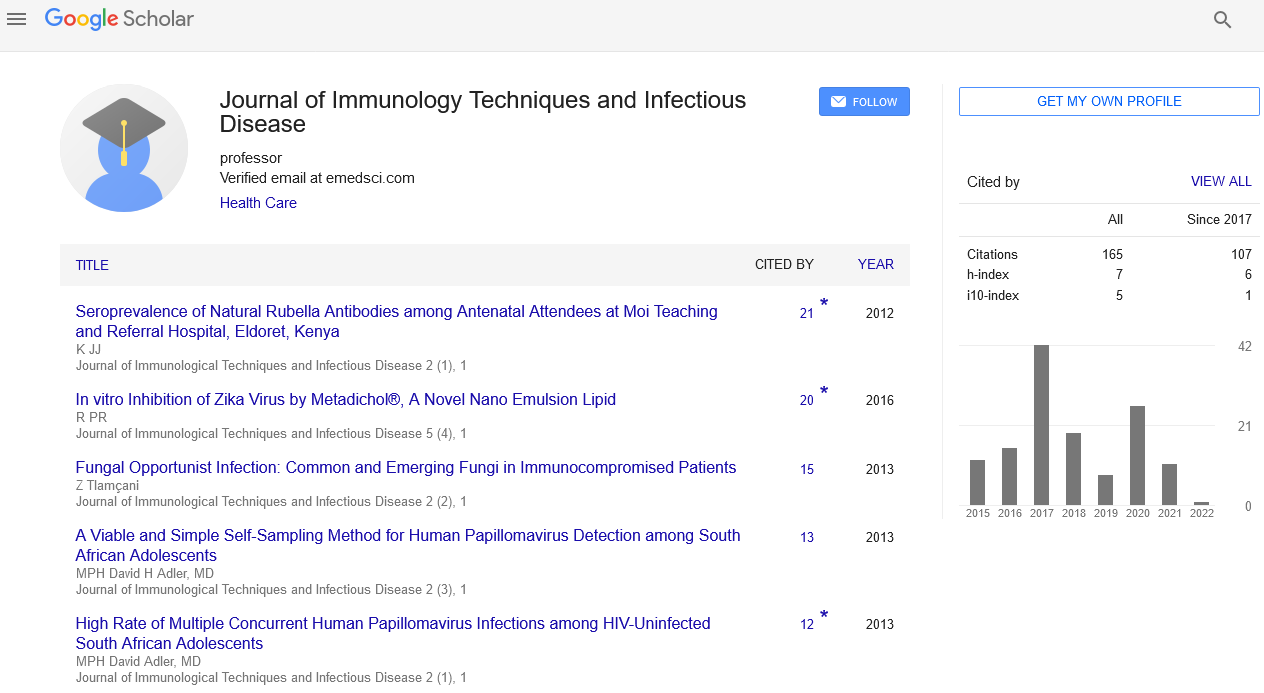Perspective, J Immunol Tech Infect Dis Vol: 11 Issue: 1
Changing Trends in Gonococcal Infections-Shift to MSM: Emerging Resistances
Hamid Reza Edraki*
Department of Immunology and Cancer Biology, University of Tabriz, East Azerbaijan, Iran
*Corresponding Author:
Hamid Reza Edraki
Department of Immunology and Cancer Biology, University of Tabriz, East Azerbaijan, Iran
E-mail:dredraki@gmail.com
Received date: 07 January, 2021, Manuscript No: JIDIT-22-56535;
Editor assigned date: 10 January, 2021; PreQC No. JIDIT-22-56535(PQ);
Reviewed date: 24 January, 2021, QC No. JIDIT-22-56535;
Revised date: 01 February, 2021, Manuscript No. JIDIT-22-56535(R);
Published date: 14 February, 2022, DOI: 10.4172/ 2329-9541.1000181.
Abstract
Typically the term is used to describe an infectious microorganism or agent such as a virus, bacterium, protozoan, prion, viroid, or fungus. Small animals such as certain worms or insects can also cause or transmit disease However these animals are usually in common parlance referred to as parasites rather than pathogens. The scientific study of microscopic organisms including microscopic pathogenic organisms is called microbiology, while parasitology refers to the scientific study of parasites and the organisms that host them. There are several pathways through which pathogens can invade a host. The principal pathways have different episodic time frames but the soil has the longest or most persistent potential for harboring a pathogen. Diseases in humans that are caused by infectious agents are known as pathogenic diseases. Not all diseases are caused by pathogens other causes are for example toxins genetic disorders and the hosts own immune system.Pathogenicity is the potential disease-causing capacity of pathogens. By this standard an organism may be said to be pathogenic or non-pathogenic in a particular context but not more pathogenic than another. Such comparisons are described instead in terms of relative virulence. Pathogenicity is also distinct from the transmissibility of a virus, which quantifies the risk of infection. A pathogen may be described in terms of its ability to produce toxins, enter tissue, colonize, hijack nutrients, and its ability to immunosuppress the host
Keywords: Gonococcal Infections
Introduction
Typically the term is used to describe an infectious microorganism or agent such as a virus, bacterium, protozoan, prion, viroid, or fungus. Small animals such as certain worms or insects can also cause or transmit disease [1]. However these animals are usually in common parlance referred to as parasites rather than pathogens. The scientific study of microscopic organisms including microscopic pathogenic organisms is called microbiology, while parasitology refers to the scientific study of parasites and the organisms that host them. There are several pathways through which pathogens can invade a host. The principal pathways have different episodic time frames but soil has the longest or most persistent potential for harboring a pathogen. Diseases in humans that are caused by infectious agents are known as pathogenic diseases. Not all diseases are caused by pathogens other causes are for example toxins genetic disorders and the hosts own immune system [2]. Pathogenicity is the potential disease-causing capacity of pathogens. By this standard an organism may be said to be pathogenic or non-pathogenic in a particular context but not more pathogenic than another. Such comparisons are described instead in terms of relative virulence. Pathogenicity is also distinct from the transmissibility of a virus, which quantifies the risk of infection. A pathogen may be described in terms of its ability to produce toxins, enter tissue, colonize, hijack nutrients, and its ability to immunosuppress the host [3].
It is common to speak of an entire species of bacteria as pathogenic when it is identified as the cause of a disease However; the modern view is that pathogenicity depends on the microbial ecosystem as a whole. A bacterium may participate in opportunistic infections in immuno compromised hosts, acquire virulence factors by plasmid infection, become transferred to a different site within the host, or respond to changes in the overall numbers of other bacteria present. For example, infection of mesenteric lymph glands of mice with yersinia can clear the way for continuing infection of these sites by lactobacillus, possibly by a mechanism of immunological scarring [4]. Virulence the tendency of a pathogen to reduce a host's fitness evolves when a pathogen can spread from a diseased host, despite the host becoming debilitated [5]. Horizontal transmission occurs between hosts of the same species, in contrast to vertical transmission which tends to evolve toward symbiosis after a period of high morbidity and mortality in the population by linking the pathogen's evolutionary success to the evolutionary success of the host organism. Evolutionary biology proposes that many pathogens evolve an optimal virulence at which the fitness gained by increased replication rates are balanced by trade-offs in reduced transmission, but the exact mechanisms underlying these relationships remain controversial. Transmission of pathogens occurs through many different routes, including airborne direct or indirect contact sexual contact through blood, breast milk, or other body fluids, and through the fecal-oral route [6].
Context-Dependent Pathogenicity
The vast majority of bacteria which can range between 0.15 μM and 700 μM in length are harmless or beneficial to humans. However, a relatively small list of pathogenic bacteria can cause infectious diseases. Pathogenic bacteria have several ways that they can cause disease [7]. They can either directly affect the cells of their host, produce endotoxins that damage the cells of their host, or cause a strong enough immune response that the host cells are damaged. One of the bacterial diseases with the highest disease burden is tuberculosis caused by the bacterium. Mycobacterium tuberculosis, which killed 1.5 million people in 2013, mostly in Sub-Saharan Africa. Pathogenic bacteria contribute to other globally significant diseases such as pneumonia, which can be caused by bacteria such as streptococcus and pseudomonas and foodborne illnesses, which can be caused by bacteria such as shigella campylobacter, and salmonella [8]. In patients with cystic fibrosis pseudomonas bacteria can form a biofilm that has a high resistance to the immune system and antibiotics by developing adaptive mutations and producing virulence factors. Pathogenic bacteria also cause infections such as tetanus typhoid fever diphtheria syphilis and leprosy.
Infections in Specific Tissue
Bacterial pathogens often cause infection in specific areas of the body. Others are generalists [9]. Bacterial vaginosis is a condition of the vaginal microbiota in which an excessive growth of gardnerella vaginalis and other mostly anaerobic bacteria displace the beneficial lactobacilli species that maintain healthy vaginal microbial populations. Bacterial meningitis is a bacterial inflammation of the meninges which are the protective membranes covering the brain and spinal cord. Bacterial pneumonia is a bacterial infection of the lungs. Urinary tract infection is predominantly caused by bacteria. Symptoms include the strong and frequent sensation or urge to urinate pain during urination and urine that is cloudy. Protozoans are single-celled eukaryotes that feed on microorganisms and organic tissues. Considered as one-celled animal as they have animal like behaviors such as motility predation and a lack of a cell wall. Many protozoan pathogens are considered human parasites as they cause a variety of diseases such as: Malaria, amoebiasis, giardiasis, toxoplasmosis, cryptosporidiosis, trichomoniasis, chagas disease, leishmaniasis, african trypanosomiasis sleeping sickness, acanthamoeba keratitis, and primary amoebic meningo encephalitis naegleriasis. Parasitic worm's helminths are macro parasites that can be seen by the naked eye. Worms live and feed in their living host, receiving nourishment and shelter while affecting the host's way of digesting nutrients. They also manipulate the host's immune system by secreting immune modulatory products. Which allows them to live in their host for years. Many parasitic worms are more commonly intestinal that are soil-transmitted and infect the digestive tract; other parasitic worms are found in the hosts blood vessels. Parasitic worms living in the host can cause weakness and even lead to many diseases. Parasitic worms can cause many diseases to both humans and animals. Helminthiasis worm infection ascariasis and enterobiasis pinworm infection are a few that are caused by various parasitic worms [10].
References
- Casadevall A, Pirofski LA (2014) Microbiology: Ditch the term pathogen. Nature 516: 165-166. [Crossref], [Google Scholar], [Indexed]
- Nathan C (2015) IMMUNOLOGY. From transient infection to chronic disease. Science 350: 161. [Crossref], [Google Scholar], [Indexed]
- Alizon S, Hurford A, Mideo N, Van Baalen M (2009) Virulence evolution and the trade-off hypothesis: History, current state of affairs and the future. J Evol Biol. 22: 245-259 [Crossref], [Google Scholar], [Indexed]
- Satoh K, Ooe K, Nagayama H, Makimura (2010) Prototheca cutis sp. nov., a newly discovered pathogen of protothecosis isolated from inflamed human skin. Int J Syst Evol Microbiol 60: 1236-1240. [Crossref], [Google Scholar], [Indexed]
- Lass-Florl C, Mayr A (2007) Human protothecosis. Clin Microbiol Rev 20: 230-242. [Crossref], [Google Scholar], [Indexed]
- Weiser JN (2013) The battle with the host over microbial size. Curr Opin Microbiol 16: 59-62. [Crossref], [Google Scholar], [Indexed]
- Malhotra S, Hayes D, Wozniak DJ (2019) Cystic Fibrosis and Pseudomonas aeruginosa: The host-microbe interface. Clin Microbiol Rev 32: 138. [Crossref], [Google Scholar], [Indexed]
- Yamamoto N, Bibby K, Qian J, Hospodsky D, Rismani- Yazdi, H et al. (2012) Particle-size distributions and seasonal diversity of allergenic and pathogenic fungi in outdoor air. ISME J 6: 1801-1811. [Crossref], [Google Scholar], [Indexed]
- Gonsalves D (1998) Control of papaya ringspot virus in papaya: A case study. Annu Rev Phytopathol 36: 415-437. [Crossref], [Google Scholar], [Indexed]
- Thumbi SM, Bronsvoort MB, Kiara H, Toye PG, Poole J, et al. (2013) Mortality in east african shorthorn zebu cattle under one year: Predictors of infectious-disease mortality. BMC Veterinary Research 9: 175 [Crossref], [Google Scholar]
 Spanish
Spanish  Chinese
Chinese  Russian
Russian  German
German  French
French  Japanese
Japanese  Portuguese
Portuguese  Hindi
Hindi 
